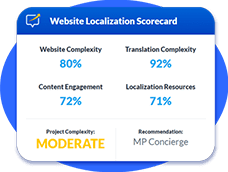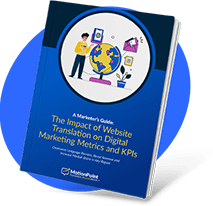Video  Jan 23, 2025
Jan 23, 2025
Insourcing Vs. Outsourcing Translation pt. 2
Welcome to three questions with MotionPoint. I'm excited to be here today with JV, Jason Brick, senior vice president of customer operations. Hi, Jason. How are you doing?
I’m doing awesome. Thanks for asking, Don. How are you?
I'm doing great. I'm grateful that you're on. Thank you very much for taking these questions. So let's get going. We're gonna be talking about insource versus outsourcing translation again from an operational perspective. So question number one.
Jason, what’s an unexpected cost when operating website translation projects in house for the first time?
The unexpected costs are not necessarily the ones that would generally be line item done in voice. There's someone hidden.
When companies try to compare the cost of managing website translation, they usually think of a per word cost. And translation is a commodity. But when companies perform the translation themselves, they generally translate much more than if they leverage motion.
The second unexpected cost is the actual opportunity cost of using their valuable IT project management and QA resources on this project instead of keeping them focused on other mission critical projects for the origin site.
Outside of the opportunity cost of diverting these teams’ times and attention, there’s the actual cost of those resources, which is why most of our customers tell us time and again that it would cost them much more to do it themselves than going promotion.
Absolutely. That makes sense. It's almost as if companies need to understand that the resources and the people or the staff that are working have to do all of that again in every single other language. So great answer.
Okay. So question number two, when it comes to insourcing versus outsourcing translation, Jason, what do companies tend to underestimate from an operational perspective the most? What would you say?
Well, it's really the overall time and level of effort. It's relatively easy to be convinced that an internal team can hire a translator or perform a translation themselves. And let's assume it's high quality translation. But who's managing the word growth and alignment of the page?
Spanish is generally twenty percent longer than English. German is forty percent longer. Longer. Does the translation fit into the call to action buttons?
What if the contents, within a JavaScript file that contains functionality? Who's performing the validation testing?
If it’s Arabic or Hebrew, who’s sharing the entire page layout, it’s set for right to left.
All of this has to be perfect not just for the delivery of the project, but everything every day out afterwards.
Yeah. The ongoing part. Yeah. It's it's one thing to think about all the technology you need, all the translation you need, the quality of it.
But the other is understanding how those translations are going to render on your on your website. Right? On the user interface of the site. Is Is it gonna break a template?
Is there gonna be misalignments?
Is all that content gonna look good?
That's that's I can see a lot of people underestimating that part of website translation till it gets there. Okay, Jason. Question number three.
So what causes companies and marketers to delay the go live date of their translated sites? What do you say is one of the most common things that you see?
Yeah. So delays occur generally when they're looking to, approve the style guide, glossary, and sample pages for their website. So the style guideline is basically the brand guide that we're going to use to determine the grade level of the translation, brand messaging date and time set for that language. The glossary is going to be the brand terms that are leveraged most prevalently across the website with SEO, taken into consideration.
And then the sample pages is a way for us to provide a a set of full page translations so they can see that fully rendered on screen.
And it's really important that we give our customers time to really go through all of this to ensure that it's really capturing their their brand's tone of voice. So that when they go after this market or new demographic, it fits perfectly for them.
Absolutely. That's a great answer, Jason, because at the end of the day, you wanna centralize and at least standardize, I would say, how you talk to every single market. Right? And not make and make sure your brand tone and voice is not all over the place but consistent so that you can scale your efforts from a marketing perspective.
Well, that's brilliant. There you go. Glossary and style guide. That does it for episode two of three questions with MotionPoint.
Until next time, thank you very much, Jason. Happy holidays, and happy New Year.
Categorieën: Websitevertaling, marketeer, activiteiten stroomlijnen, prestaties optimaliseren, video





Delen: